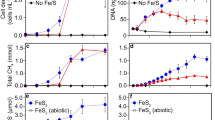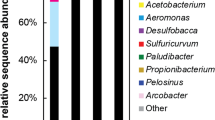Abstract
THE formation of pyrite (FeS2), an important factor in determining the global redox balance1, has recently attracted biological interest as a possible direct source of energy for early life2–5. The theory implies that carbon dioxide fixation, in competition with hydrogen formation, can serve as the electron sink for pyrite formation and it seems to be supported by the detection of minute grains of pyrite and iron sulphides inside bacteria5–8. Yet it clashes with the conventional assumption that elemental sulphur or a sulphur equivalent (polysulphide or thiosulphate) is the mandatory oxidant for pyrite formation9,10. It has been stressed that the reaction FeS + H2S→FeS2 + H2 (with H+ as the oxidant) has "never been observed … during several years of experimentation"10. Here we report the formation of both pyrite and molecular hydrogen under fastidiously anaerobic conditions in the aqueous system of FeS and H2S.
This is a preview of subscription content, access via your institution
Access options
Subscribe to this journal
Receive 51 print issues and online access
$199.00 per year
only $3.90 per issue
Buy this article
- Purchase on Springer Link
- Instant access to full article PDF
Prices may be subject to local taxes which are calculated during checkout
Similar content being viewed by others
References
Jorgensen, B. in Autotrophic Bacteria (eds Schlegel, H. G. & Bowien, B.) 117–146 (Science Tech, Madison, 1989).
Wächtershäuser, G. Syst. appl. Microbiol. 10, 207–210 (1988).
Wächtershäuser, G. Microbiol. Rev. 52, 452–484 (1988).
Wächtershäuser, G. Proc. natn. Acad. Sci. U.S.A. 87, 200–204 (1990).
Popper, K. R. Nature 344, 387 (1990).
Farina, M., Esquivel, D. M. S. & Lins de Barros, H. G. P. Nature 343, 256–258 (1990).
Mann, S., Sparks, N. H. C., Frankel, R. B., Bazylinski, D. A. & Jannasch, H. W. Nature 343, 258–261 (1990).
Williams, R. J. P. Nature 343, 213–214 (1990).
Roberts, W. M. B., Walker, A. L. & Buchanan, A. S. Miner. Deposita 4, 18–29 (1969).
Berner, R. A. Am. J. Sci. 268, 1–23 (1970).
Hall, A. J. Miner. Mag. 50, 223–229 (1986).
Boesen, C. & Postma, D. Am. J. Sci. 288, 575–603 (1988).
Allison, P. A. in Palaeobiology (eds Briggs, D. E. G. & Crowther, P. R.) 253–255 (Blackwell Scientific, Oxford, 1990).
Schlegel, H. G. in Autotrophic Bacteria (eds Schlegel, H. G. & Bowien, B.) 305–330 (Science Tech, Madison 1989).
Author information
Authors and Affiliations
Rights and permissions
About this article
Cite this article
Drobner, E., Huber, H., Wächtershäuser, G. et al. Pyrite formation linked with hydrogen evolution under anaerobic conditions. Nature 346, 742–744 (1990). https://doi.org/10.1038/346742a0
Received:
Accepted:
Issue Date:
DOI: https://doi.org/10.1038/346742a0
This article is cited by
-
A review of the mechanisms of mineral-based metabolism in early Earth analog rock-hosted hydrothermal ecosystems
World Journal of Microbiology and Biotechnology (2019)
-
Bedeutung von Pyritmineralen für die Grundwasserchemie
Grundwasser (2015)
-
Die Chemie am Ursprung des Lebens
BIOspektrum (2013)
-
Polymersomes Containing Iron Sulfide (FeS) as Primordial Cell Model
Origins of Life and Evolution of Biospheres (2011)
-
Dynamics of oxidized and reduced iron in a northern hardwood forest
Biogeochemistry (2011)
Comments
By submitting a comment you agree to abide by our Terms and Community Guidelines. If you find something abusive or that does not comply with our terms or guidelines please flag it as inappropriate.



